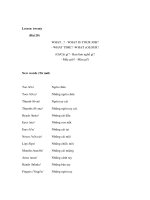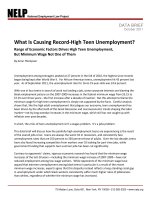what is money
Bạn đang xem bản rút gọn của tài liệu. Xem và tải ngay bản đầy đủ của tài liệu tại đây (230.74 KB, 10 trang )
Copyright 2011
Pearson Canada Inc.
3 -
1
Chapter 3
What Is Money?
Copyright 2011
Pearson Canada Inc.
3 -
2
Meaning of Money
•
Money - anything that is generally accepted in
payment for goods or services or in the
repayment of debts; a stock concept
•
Wealth - the total collection of pieces of
property that serve to store value
•
Income - flow of earnings per unit
of time
Copyright 2011
Pearson Canada Inc.
3 -
3
Functions of Money
•
Medium of Exchange - promotes economic efficiency
by minimizing the time spent in exchanging goods
and services
•
Unit of Account - used to measure value in
the economy
•
Store of Value - used to save purchasing power; most
liquid of all assets but loses value during inflation
Copyright 2011
Pearson Canada Inc.
3 -
4
Functions of Money I
•
If money is not unique as a store of value, why
do people hold money?
–
The answer is liquidity, the relative ease and speed
which an asset can be converted into a medium of
exchange.
Copyright 2011
Pearson Canada Inc.
3 -
5
Evolution of the Payments System
•
Commodity Money
•
Fiat Money
•
Cheques
•
Electronic Payment
•
E-Money
Copyright 2011
Pearson Canada Inc.
3 -
6
Measuring Money I
•
Float – funds in transit between the time a
cheque is deposited and the time the payment
is settled.
•
Measures of Money Supply:
–
M2
–
M3
–
M2+
Copyright 2011
Pearson Canada Inc.
3 -
7
Measuring Money II
Copyright 2011
Pearson Canada Inc.
3 -
8
Money as a Weighted Aggregate
•
The Bank of Canada’s money supply measures
are ‘simple-sum’ indices, the index
M = x
1
+ x
2
+ … + x
n
,
Where x
j
is one of the n monetary components
of the monetary aggregate M
• Weighted monetary aggregates seem to
predict inflation and the business cycle
somewhat better than the conventional
measures
Copyright 2011
Pearson Canada Inc.
3 -
9
Measuring Money
Copyright 2011
Pearson Canada Inc.
3 -
10
How Reliable are the Money Data?
•
Revisions are issued because:
–
Small depository institutions report
infrequently
–
Adjustments must be made for seasonal
variation
•
We probably should not pay much attention to
short-run movements in the money supply
numbers but should be concerned only with
longer-run movements.









